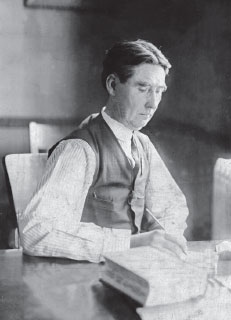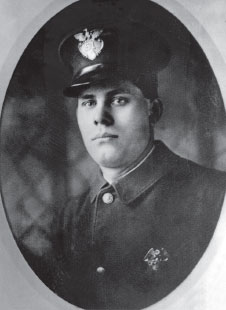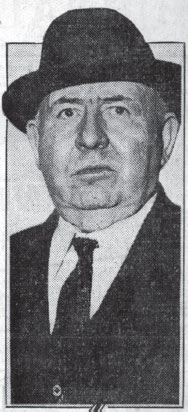Akron had the world’s first motorized police wagon, a 5,500-pound, battery-powered vehicle built by city electrician Frank Loomis in 1899. Courtesy of Akron Police Museum.
Rage and anarchy filled the streets of downtown Akron during the riot of August 21, 1900, the darkest night in the city’s history. A lynch mob demanded that police turn over Louis Peck, a thirty-six-year-old black man accused of criminally assaulting a six-year-old white girl, Christina Maas.
An angry crowd grew from a few hundred people to five thousand outside the Akron City Building, where the mayor, council and other municipal leaders kept their offices and where Akron police operated a twelve-cell jail at South Main Street and Quarry (now Bowery Street). Sheriff Frank Kelly had secretly whisked Peck to Cleveland’s jail for safekeeping earlier in the day, but the stubborn vigilantes refused to believe it.
Hooligans stole the Akron department’s pride and joy, the world’s first motorized police wagon, a 5,500-pound, battery-powered vehicle built by city electrician Frank Loomis in 1899, and dumped it unceremoniously into the Ohio & Erie Canal.
Refusing Chief Hughlin H. Harrison’s orders to disperse, the mob threw rocks and bricks, shattered windows and formed a battering ram to smash down the city building’s door. From second-floor windows, officers fired shots into the seething crowd, killing two onlookers—Glen Wade, ten, and Rhoda Davidson, seven—and wounding several men. The revenge-minded mob exploded in violence, storming the building, setting it ablaze and blasting it with dynamite.
Akron had the world’s first motorized police wagon, a 5,500-pound, battery-powered vehicle built by city electrician Frank Loomis in 1899. Courtesy of Akron Police Museum.
Escaping through a basement door, Harrison fled in terror. Flames licked the night sky as the city hall and adjacent buildings shuddered and collapsed. When the state militia arrived early the next day to restore order, it was eerily quiet. Wire dispatches appeared in newspapers across the continent, shaming the city:
When day dawned in Akron this morning it revealed a scene of desolation and the evidences of violence and lawlessness unparalleled in the history of the city. The rioters had done their awful work and disappeared.…The city building was a heap of smouldering ruins and beside it steamed the water-soaked ashes of Columbia Hall. The chief had left the city. The police force of the city was disorganized and scattered.
Akron was left to pick up the pieces. Chief Harrison resigned in humiliation after losing the respect of officers and citizens. Patrolman John Durkin, forty-two, a seasoned cop who joined the force in 1883, was installed as chief for $1,200 per year. Dozens of rioters were arrested and sentenced for their roles in the awful melee. Louis Peck was convicted of rape in a hasty trial without legal counsel, sentenced to life imprisonment and spent thirteen years at the state penitentiary before winning a full pardon over lingering doubts of his guilt and due process.

Chief John Durkin, a seasoned cop who joined the force in 1883, modernized the Akron Police Department following the deadly riot of 1900. From the Akron Beacon Journal.
Upon being promoted in December 1900, Durkin announced that he would modernize the police department and regain the public’s confidence. “I will prepare and recommend to the board of city commissioners a more complete system than the present one to regulate the work and duties of patrolmen,” he said. “It will take some time to get everything in perfect working order but I am certain that every officer on the force will do everything in his power to assist in making it up to date and metropolitan.”
An Irish American officer who spoke with a brogue, Durkin stood about six-foot-three and was known to be an affable fellow but hard as nails when necessary. He pleaded with the city for additional manpower—“To have a strong department in Akron we must have more officers”—and was rewarded with the hiring of a dozen cops, bringing the force’s size to forty-eight. Breaking with tradition, Durkin declined to wear a uniform. “The time was when it was quite the thing for a chief of police to appear in a gay uniform bedecked with gold braid and brass buttons, but modern chiefs in all metropolitan cities are content to appear in a modest, ordinary, everyday suit of clothes,” he explained.
Durkin reassigned beats and ordered officers to shave off their mustaches to present a more tidy appearance. He established a traffic bureau, vice squad, cruiser squad and Bertillon criminal identification system and presided over the 1909 opening of a new police station at South High Street and present-day Bowery. Thanks to Durkin’s efforts, the Akron Police Department rose from the ashes of the 1900 riot and emerged as a modern, professional force. Criminals beware.
With only two days to go until Christmas 1917, Patrolman Guy Norris walked the midnight beat in his South Akron neighborhood. It was supposed to be a season of joy, but the city wasn’t following the program, with shootings, stabbings and muggings—so much for peace on earth and goodwill toward men.

Patrolman Guy Norris, regarded as one of the toughest cops on the force, joined the Akron Police Department in 1915. From the Akron Beacon Journal.
The twenty-eight-year-old officer met a lot of rugged characters on the job—it came with the territory. His beat included Hell’s Half Acre, a notorious district south of downtown where young hoodlums from rival ethnic groups often battled for supremacy. Located around South Main Street, Thornton Street and Washington Street, the zone owed its hellish nickname to the nineteenth-century Akron Iron Company, whose twenty-four-hour blast furnace tinted the night sky with an eerie, reddish glow until an arsonist burned the place to the ground in 1897.
A rugged character himself, Norris developed a reputation as one of the toughest cops in the department during two and a half years on the job. The former electrician, a native of Freedom Township in Portage County, joined the Akron force in 1915 after working at the Quaker Oats factory.
In those days, officers were issued a badge, club, whistle, cap and helmet but had to pay for their uniform and gun. They patrolled their beats by foot—after all, there were only four automobiles in the entire department—and got to know the neighborhoods one face at a time, learning the names of residents and business owners and observing the comings and goings of strangers.
When gamblers set up shop in the basement of John Oeschner’s tailor shop, Norris raided the business single-handedly and made seven arrests. When teens Dan McGowan and Charles Martin went on a joyride in a stolen automobile, he whistled them to a stop and confiscated the vehicle on South Main Street. When inebriated New York traveling salesmen Avery Hickey and Albert Streeter engaged in fisticuffs in the street, he broke up the fight and let them sleep it off in the city jail.
Norris made headlines twice during his first two years on the job, and both times, he wished he hadn’t. As a rookie of only a few months, he nearly lost his life late one night in July 1915 while patrolling his original beat on North Hill. As Norris later told his superiors, he was passing the Otto Schwarz home on East Tallmadge Avenue at 1:25 a.m. when a mysterious noise caught his attention. Schwarz, a Goodrich employment manager, had also heard the noise and rose from bed to investigate. As Norris crept closer, Schwarz heard approaching footsteps, assumed a burglar was trying to break into his home, opened a window and fired a revolver. Norris felt a bullet whiz past his ear.
“Hey, what’s the matter with you?” Norris cried out.
“Oh,” Schwarz replied after poking his head through the window and seeing the cop. Norris and Schwarz looked around but couldn’t find the source of the earlier noise. “I just wanted to scare the fellow, anyway,” Schwarz told the officer about the imaginary burglar. “I didn’t shoot right at you.”
A year later, Norris was called on the carpet at Safety Director Charles R. Morgan’s office to explain a 1916 altercation on Miami Street in South Akron. Norris and Patrolman James J. McFarland went to the home of Star Drill Company employee Henry George in search of a vandal who shattered the front window of a South Main Street saloon. George told the officers they had the wrong address, but he said they pushed him aside, roughed him up and ransacked the house in a futile attempt to find the suspect.
George claimed that Norris punched him several times, knocking out a tooth and giving him a black eye. However, the patrolman told his bosses that the resident injured himself when he made a mad rush at the officer and ran into his open hand, which the patrolman had extended to halt him. George filed a $10,000 lawsuit against the two cops, but local newspapers didn’t report the outcome. The case may have been settled quietly out of court. Or maybe it was dropped during the citywide crisis that followed.
Two days before Christmas 1917, Norris trudged his usual route. It was a clear night with days-old snow on the ground, a first-quarter moon and frosty temperatures in the twenties. Norris was only a few blocks away from his Grant Street home in the Wolf Ledge district, where his wife, Hulda, and sons Russell, three, and Ralph, one, presumably were asleep.
He had started the shift at 7:00 p.m. and checked in with headquarters at the top of each hour. Around 1:30 a.m. on Sunday, December 23, the six-foot, 190-pound patrolman discovered six men in a heated dispute in front of the Akron Brewing Company at Voris Street and South High Street (a block that was later renamed South Broadway). The patrolman interrupted the quarrel between three Hungarians and three Italians. The Hungarians complained to the officer that the Italians tried to pick a fight with them, and one had flashed a handgun. The patrolman noticed that the Italians were hurrying north, so he followed them and ordered them to stop. “Throw up your hands!” Norris ordered.

Detective Bert Eckerman, a member of the force since 1903, kept a vigil at the bedside of mortally wounded Guy Norris in December 1917. From the Akron Beacon Journal.
It was a common procedure among Akron police to stop suspicious-looking men to search for weapons. Norris lost track of all the times he had patted down men for knives and guns. This time, however, the routine assignment turned horribly wrong. As Norris searched the pockets of one of the Italians, another reached into his overcoat, pulled a revolver and shot the patrolman in the chest from about three feet away. The blast echoed through the neighborhood. Norris collapsed to the sidewalk as the hoodlums escaped east on Thornton Street.
Julius Kordos, who operated a coffeehouse on South High Street, heard the gunshot and went outside to investigate. He found a dark heap in front of a home at 778 South High Street. The bloodied officer was alive and alert but paralyzed from the shoulders down, with a bullet in his spinal cord. Kordos called police.
From a bed at Akron City Hospital, Norris told Detective Bert Eckerman what had happened. He couldn’t provide a good description of the gunman or accomplices, though, other than to say they were Italians. Police Chief John Durkin put fifteen patrolmen and two captains on the case. The dragnet turned the neighborhood upside down but failed to turn up any clues. Even the three Hungarians who came forward to corroborate the patrolman’s story were unable to identify any suspects.
Eckerman stayed at Norris’s bedside all day and night. The patrolman lost consciousness around 9:30 p.m. Sunday and was pronounced dead at 4:30 a.m. Monday, Christmas Eve. He was the first officer to die in the line of duty in the forty-five-year history of the Akron force.
“He was literally afraid of nothing,” a grief-stricken Eckerman told the Akron Beacon Journal. “He was always ready for the most hazardous work, and kept his beat in the best of order at all times.”
Overlooking the lawsuit from a year earlier, Safety Director Morgan eulogized, “There was never a complaint against him, and I considered him one of the very best policemen we had.”
After a somber Christmas, most of the police force turned out for Patrolman Guy Norris’s funeral at 2:00 p.m., December 27, at Concordia Lutheran Church. Hundreds of officers, relatives and friends packed the memorial service. Patrolmen Gethin Richards, Fred Viereck, Paul Krause, Edward Hieber, Verne Cross and Harry Black served as pallbearers. Norris was buried at Mount Peace Cemetery.
Chief Durkin pledged that the department would find the killer and bring him to justice. Summit County commissioners offered a $500 reward. Yet the trail soon grew cold.
“In an attempt to locate the murderers of Patrolman Norris, Akron police are putting every suspicious-looking foreigner they find through the third degree,” the Beacon Journal reported on December 29. “Saturday morning, the chief had two men at headquarters, and for over an hour, tried to get some information out of them, but finally gave it up. While announcing that it was ‘a bum steer,’ the police are still holding the suspects for further investigation.”
Police prosecutor Owen M. Roderick urged officers to wage a campaign against illegal guns. He estimated that nearly half of Akron’s foreign population carried concealed weapons, although he didn’t explain how he determined that figure. He proposed weekly sweeps in saloons to search every man for weapons. Although it didn’t come to that, officers did turn up the heat on immigrants, especially Italians.
No one ever was put on trial for the murder of Patrolman Norris. In a few short weeks, though, the motive for the slaying became terribly clear.
Akron was still in deep shock as 1918 arrived. Officers had trouble comprehending the tragic death of their friend and colleague. It simply was unthinkable that anyone would kill an Akron officer, a crime that had never before been committed in the city. And then the unthinkable happened again.